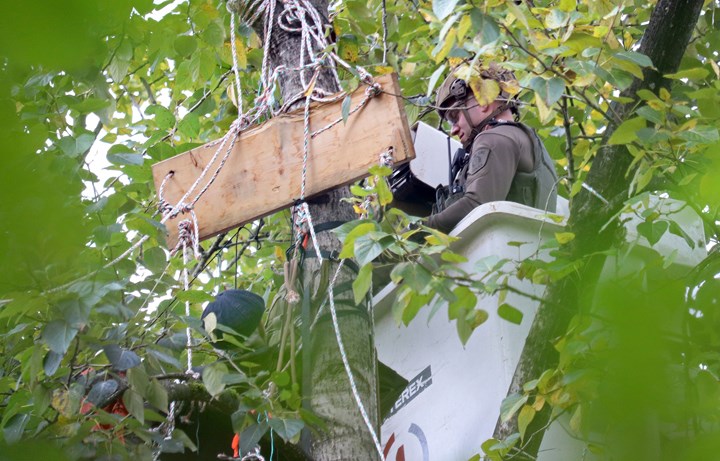CANADA LETTER
Alberta’s ‘Best Summer Ever’ Ends With an Overwhelmed Medical System
A surge of Covid-19 cases has forced the province to ask for military assistance in airlifting patients to hospitals across the country.
By Ian Austen
Sept. 24, 2021
Premier Jason Kenney was roundly criticized by public health experts in June when he declared victory over the coronavirus and made Alberta the first province to largely lift pandemic restrictions.

Jason Kenney, the premier of Alberta, in his office in Calgary
“We finally have the upper hand on this virus and can safely open up our province,” Mr. Kenney said at a podium with a sign declaring the province was “open for summer.” Over at his United Conservative Party’s website, supporters could buy caps embroidered with the slogan: “Best Summer Ever, Alberta 2021.”
Last week, Mr. Kenney was back with a less triumphal message: the declaration of a public health emergency, while reimposing more restrictions for the second time this month, and appointing a new health minister.
As of Thursday, Alberta had 20,180 active Covid cases, nearly half of all cases in Canada, straining intensive care units at hospitals to the point that the provincial government has asked for military assistance to fly patients thousand of miles to be treated in other provinces. Since Mr. Kenney lifted restrictions on Canada Day, Covid has killed 308 people in Alberta.
“I know that we had all hoped this summer that we could put Covid behind us once and for all; that was certainly my hope,” Mr. Kenney said on Sept. 16. “It is now clear that we were wrong, and for that I apologize.”
Many members of Alberta’s medical community bluntly dismissed Mr. Kenney’s comments for coming, in their view, weeks too late to stem the crisis, and said that his new public health measures were far short of what was needed.
“We’re already at the point where our health care system has functionally collapsed,” Dr. Ilan Schwartz, an infectious disease specialist at the University of Alberta, told me on Friday. “Yet we have a society continuing as if nothing is awry.”

Dr. Schwartz is among many in the province’s medical community who began raising the alarm during the summer, as the Delta variant combined with Alberta’s comparatively low vaccination rates prompted a rise in infections and hospital admissions. (With just 61.9 percent of Albertans fully vaccinated compared with the national rate of 69.7 percent, the province is second only to Saskatchewan for having the lowest rate of vaccine take-up.)
At the beginning of September, Alberta introduced some pandemic control measures. But Dr. Schwartz said that they were inadequate and often ineffective.
“As if an alcohol curfew of 10 p.m. could ward off the virus,” he said. Rather than keeping crowds from packing nightclubs, Dr. Schwartz added, the measure only meant that “people were just going out to party earlier.”
On the day of Mr. Kenney’s apology, his government announced a variety of renewed restrictions and rules, including those involving masks. But given the level of severity of the situation, Dr. Schwartz said that the new safety measures would not be nearly enough to prevent the health care system from being overwhelmed. Alberta, in his view, needed to introduce a “hard lockdown” where most things other than essential retail and services would be closed.
Sign up for the Canada Letter Newsletter Back stories and analysis from our Canadian correspondents, plus a handpicked selection of our recent Canada-related coverage. Get it sent to your inbox.
He particularly noted, with disapproval, the plans to allow N.H.L. games to take place in front of tens of thousands of fans in Calgary and Edmonton. While fans will need proof of vaccination or a recent negative test result to enter, several news outlets have reported that Alberta’s vaccine document, like Ontario’s, can be easily edited or faked using only minimal computer skills.
“We really have no option but to go into a hard lockdown, what we’re calling a firebreak,” he said. “Basically, we have a raging forest fire — Albertans are familiar with the imagery. We’re calling for removing some of the combustible elements, in this case people, out of the way.”
Instead, Mr. Kenney’s government has mostly promised to give more resources to hospitals. However, Dr. Schwartz said that such extra resources were impossible to provide because of shortages of trained medical staff.
He did not foresee Alberta’s situation improving until the government shut the province down.
“I never would have imagined that this could happen in Canada,” Dr. Schwartz said. “We’re at such a desperate point. It’s extremely demoralizing to health care workers. It’s terrifying to patients and to individuals who are chronically ill. That the government hasn’t implemented a meaningful hard lockdown at this point, while perhaps politically unpopular, it boggles my mind.”
Where We Left Off

In an election that somehow seemed both interminable and yet over in a flash, Canada now finds itself with a Liberal minority government in a Parliament that looks pretty much like the one that Prime Minister Justin Trudeau had dissolved to allow a vote.
Our coverage included an analysis I wrote with Dan Bilefsky of how Canada got back to where it began. You can find The Times’s Election Day article here, and here’s our Election Day briefing.
For those of you who missed it, I offered four takeaways from the campaign in a special edition of this newsletter. And my political profile of Mr. Trudeau appeared shortly before Monday’s vote.
Trans Canada

After more than 1,000 days, Michael Kovrig and Michael Spavor, the two Canadians jailed by China in apparent retaliation for the arrest of Meng Wanzhou, the Chinese telecom executive, were on their way home Friday night after a day of developments. First Ms. Meng, the chief financial officer at Huawei, appeared virtually in an American court to settle a fraud case against her by admitting some wrongdoing. She then went to a court in Vancouver, where it was announced that the United States had dropped its extradition request related to those fraud charges, which had led to her arrest at that city’s airport in 2018. Ms. Meng left Vancouver for China at about the same time that Mr. Kovrig and Mr. Spavor were released by the Chinese authorities and boarded a flight for Canada.
Manohla Dargis, a New York Times film critic, wrote that after attending the Toronto International Film Festival, where screenings were held in largely empty cinemas because of the pandemic, “I was reminded that a film festival isn’t simply a series of back-to-back new movies. It’s also people, joined together, and ordinarily jammed together, as one under the cinematic groove.”














